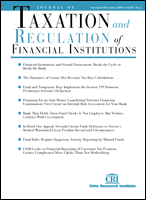Complete Issue
Author: Houman B. Shadab.
Source: Volume 24, Number 05, May/June 2011 , pp.1-56(56)

< previous article |return to table of contents
Abstract:
A wide variety of tax and financial law issues are presented for sophisticated practitioner analysis in this issue of the Journal of Taxation and Regulation of Financial Institutions. Our first article examines the withholding tax treatment of total return equity swaps. Luis Rodriguez, Jr., examines the evolution of how equity swaps are taxed, culminating in the changes brought about by the Hiring Incentives to Restore Employment Act of 2010 (the HIRE Act). Although the HIRE Act resolved differences in the withholding tax treatment between payments to foreign investors made pursuant to equity swaps versus those made pursuant to ordinary dividends, as Mr. Rodriguez notes, the HIRE Act amendments have created new problems—for example, how existing equity swaps should be treated and whether the withholding tax applies to fully synthetic swaps. Financial law practitioners of course need to be aware of how existing legal arrangements can benefit their clients. One often overlooked area, detailed in our second article, is the Small Business Administration (SBA) program that helps banks to make assetbased loans to small- and medium-sized business. As Daniel Godfrey notes, the SBA’s CAPLines program provides a 75 percent government-backed credit guarantee to banks and other qualifying providers of asset-based loans. Understanding the nuances of the program is important; lenders can substantially remove much of the risk traditionally associated with asset-based loans and thereby benefit from a potentially valuable source of income. After Lehman Brothers collapsed in September 2008, a major difference in the way U.S. and U.K. law protected customer assets—including those of U.S. investors—in relation to a brokerage’s bankruptcy came to the forefront. As discussed by New York Law School Professor Ron Filler in our third article, U.K. law did not offer the same protection for customer assets as does U.S. law, which requires that customer property be fully segregated in a separate account and protected in the event of a brokerage’s bankruptcy. Professor Filler details the comparative weaknesses in the U.K. regime’s approach, pending case law on point, and the U.K.’s Special Administration Regime for U.S.-based investment banks, which came into effect in February of 2011. While enforcement actions by the Securities and Exchange Commission (SEC) are traditionally aimed at corporate issuers, in recent years the SEC has focused on municipalities raising funds from the public. As Adam Gordon notes in this issue’s fourth article, recent SEC enforcement actions against municipal issuers highlight the importance of disclosure practices. Mr. Gordon suggests several “best practices” that can help municipalities to avoid running afoul of the securities laws. Roy Crawford’s column on recent developments in state and local tax law rounds out this issue. He discusses a proposed—and quickly abandoned—Idaho tax rule regarding apportionment of financial institutions’ income and interest add-back statutes such as New Jersey’s.Keywords:
Affiliations:
1: New York Law School and Journal Editor.